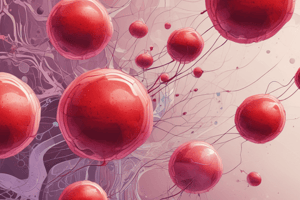Podcast
Questions and Answers
What is the primary function of red blood cells?
What is the primary function of red blood cells?
- Serving as the main component of the immune response
- Transporting oxygen to cells and tissues and taking carbon dioxide away (correct)
- Transporting nutrients to cells and tissues
- Producing hormones for metabolic regulation
What differentiates red bone marrow from yellow bone marrow?
What differentiates red bone marrow from yellow bone marrow?
- Yellow bone marrow is primarily found in children
- Red bone marrow contains only fat cells
- Red bone marrow produces blood cells, while yellow bone marrow does not (correct)
- Yellow bone marrow produces red blood cells
What happens to immature red blood cells as they mature?
What happens to immature red blood cells as they mature?
- They transform into white blood cells
- They lose hemoglobin production capabilities
- They gain additional nuclei and ribosomes
- Their nucleus shrinks and eventually disappears (correct)
What is a significant consequence of having a lower than normal number of red blood cells?
What is a significant consequence of having a lower than normal number of red blood cells?
How do red blood cells assist in the clotting process?
How do red blood cells assist in the clotting process?
Which disorder is characterized by having abnormally shaped red blood cells?
Which disorder is characterized by having abnormally shaped red blood cells?
What is the average lifespan of mature red blood cells in circulation?
What is the average lifespan of mature red blood cells in circulation?
What is the main function of red blood cells in the human body?
What is the main function of red blood cells in the human body?
What physical characteristic of red blood cells helps them navigate through tiny capillaries?
What physical characteristic of red blood cells helps them navigate through tiny capillaries?
What specific protein within red blood cells binds to oxygen?
What specific protein within red blood cells binds to oxygen?
Where do red blood cells begin their life cycle?
Where do red blood cells begin their life cycle?
How long do red blood cells typically live before being destroyed?
How long do red blood cells typically live before being destroyed?
What percentage of total blood volume do red blood cells typically comprise?
What percentage of total blood volume do red blood cells typically comprise?
What happens to red blood cells after their lifespan ends?
What happens to red blood cells after their lifespan ends?
What feature of hemoglobin allows it to bind oxygen effectively?
What feature of hemoglobin allows it to bind oxygen effectively?
Flashcards are hidden until you start studying
Study Notes
Red Blood Cell Function
- Red blood cells deliver oxygen from the lungs to all cells in the body.
- Red blood cells carry carbon dioxide back to the lungs for expulsion.
- Red blood cells make up about 40-45% of total blood volume.
Anatomy and Description
- Red blood cells are small, disc-shaped cells without a nucleus, resembling a doughnut.
- Their small size allows them to pass through tiny capillaries for oxygen-carbon dioxide exchange.
- Red blood cells contain hemoglobin, a protein with heme, which contains an iron ion that binds to oxygen.
Life Cycle
- Red blood cells live for about 120 days, circulating in the blood.
- They are produced in bone marrow and destroyed by cells in the liver and spleen.
Production
- Red blood cells are made in red bone marrow found in the center of long bones, as well as in spongy bone.
- Hemocytoblasts, stem cells in red bone marrow, differentiate into proerythroblasts, immature red blood cells with a nucleus.
- Proerythroblasts make hemoglobin and lose their nucleus to become mature red blood cells (erythrocytes).
Mature Red Blood Cells
- Mature red blood cells are released into the bloodstream from bone marrow.
- They have a long lifespan (about 120 days) and circulate continuously.
- Approximately 1% of red blood cells are replaced daily.
Death of Red Blood Cells
- After 120 days, red blood cell membranes break down.
- Cells in the spleen and liver destroy dying red blood cells and recycle their hemoglobin.
Functions
- Primary functions of red blood cells are oxygen transport and carbon dioxide removal.
- They also play a role in blood clotting by :
- Increasing blood viscosity, making clots more likely.
- Clotting is impaired in people with low red blood cell counts.
Oxygen and Carbon Dioxide Transport
- Hemoglobin in red blood cells binds to oxygen in the lungs.
- Oxygen is released from red blood cells in tissues and organs.
- Carbon dioxide from cellular respiration enters red blood cells and is converted for storage.
- Red blood cells return to the lungs, release carbon dioxide, and pick up more oxygen.
Red Blood Cell Disorders
- Anemia: low red blood cell count.
- Causes: blood loss, iron deficiency, underlying disorder.
- Treatment: depends on the cause, may include iron supplements or blood transfusions.
- Sickle Cell Disease: abnormally shaped red blood cells increase the risk of clotting.
- Causes: genetic mutation.
- Symptoms: significant pain and anemia.
- Treatment: medications to prevent clotting, blood transfusions, stem cell transplants.
- Thalassemia: red blood cells contain abnormal hemoglobin, leading to chronic oxygen deficiency.
- Causes: genetic mutation.
- Symptoms: growth delays, heart and spleen damage.
- Treatment: blood transfusions, stem cell transplants.
- Polycythemia vera: blood cancer with excessive red blood cell production due to a genetic mutation.
- Symptoms: increased risk of blood clots leading to stroke or heart attack.
- Treatment: regular bloodletting.
Studying That Suits You
Use AI to generate personalized quizzes and flashcards to suit your learning preferences.




